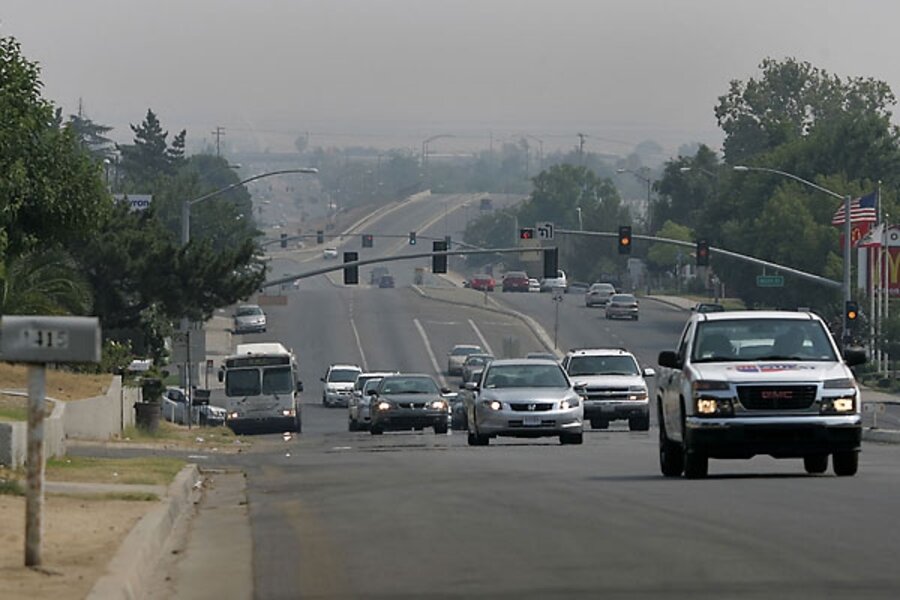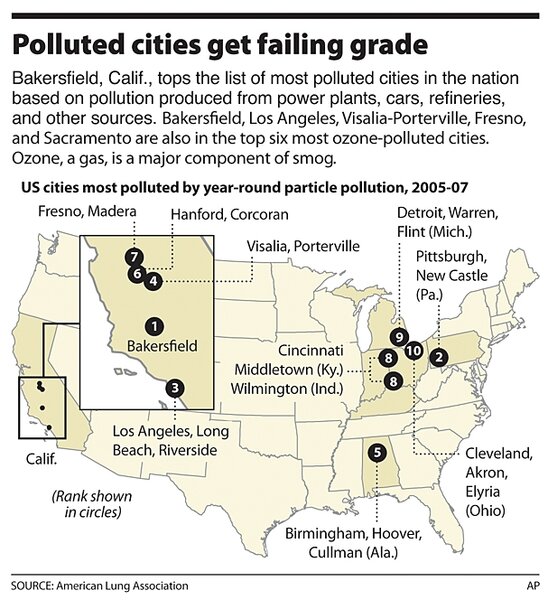The worst air in the US? It's not in L.A.
Loading...
| Bakersfield, Calif.
At Uricchio’s Trattoria, a street café on 17th Street, the smell of sizzling garlic wafts into the air tinged lightly with the aroma of … exhaust. And despite the perfect blue sky, the view of the mountains surrounding this Central Valley city is obscured by a ruddy haze.
As Lois and Jill Moreland sip coffee and spear salad greens, they comment on the placement of a national story on smog in the Bakersfield Californian newspaper. “It only made the cover of the B-section,” says Lois.
Bakersfield has moved into first place as the city with the most fine particulate pollution, according to report released Wednesday by the American Lung Association, which annually ranks America’s cities with the unhealthiest air. Last year, the city was third behind Pittsburgh and Los Angeles.
For the third year in a row, Bakersfield ranks as the nation’s second smoggiest city. It comes in just behind Los Angeles in the cities most polluted by ozone, the gas that forms a major component of smog.
Local TV has already broadcast the story and national reporters have shown up, but the Moreland sisters seem unfazed. “Smog is a way of life here,” says Jill.
It’s been more than a decade since the first reports about the growing pollution threatening America’s most diverse and productive farm counties here in the Central Valley. The reasons for the pollution are manifold, including dust from tractors and mist from fertilizers and pesticides that grow half the nation’s produce.
But the topography and meteorological conditions make matters worse – and make the problem hard to solve. The city is boxed in on three sides by mountains. Inversion layers – which act like a lid on the air, holding the pollution close to the ground – are present in both winter and summer, and there is little or no wind to take the pollution elsewhere.
Kern County, in which Bakersfield is situated, and also ranks as the worst county in average annual particulate pollution, has made some efforts to reduce the pollution.
According to the San Joaquin Valley Air Pollution Control District, the county has reduced stationary sources of pollution by 80 percent since 1980, through measures including regulations on oil processing and, in 2003, restrictions on wood fires. Farming regulations that reduced both the number of harvesting machines and the number of trips through the field have also helped.
But officials now say they need state and federal help to control the heavy-duty trucks that pass through on Interstate 5 and Highway 99, and cut east to west hauling produce from farms to packaging facilities.
“Unfortunately, all these big trucks fall outside our regulatory authority,” says Seyed Sadredin, the district’s executive director and air pollution control officer.
So far, pollution controls have cost county businesses about $40 billion, he says. Two plans, one to reduce particulate matter by 2015 and another to reduce ozone by 2023, will cost another $20 billion.
“This is all very costly and in the current economic crisis is even more of a challenge,” says Mr. Sadredin.
The cost of noncompliance with pollution standards may be more, he says. Being out of compliance with federal Environment Protection Agency standards costs the county $2 billion in forfeited federal highway funding and puts a dent in its ability to attract more businesses.
Other intangible costs are just as important, notes Bonnie Holmes-Gen, senior policy director for the California chapter of American Lung Association (ALA), pointing to the poor lung capacities of the young people who grow up in such an environment. A California State University, Fullerton study estimated the economic cost of not meeting EPA air standards for the southern California region, which includes the Los Angeles area, at $6 billion per year in health-related costs and premature deaths. (Editor's note: The original version misidentified the university.)
“Sure it costs money to clean up the air, but we are already paying costs with the health of young people, increased medication, and shortened lives,” says Ms. Holmes-Gen. The ALA is working with local governments and promoting partnerships between the county, state, and federal authorities.
“The San Joaquin Air Pollution District has done much to lower the pollution in this area and should be applauded,” says Holmes-Gen. “But there is a lot more they can do. Their hands are not tied.”
This year, 12 more California counties received failing grades than did last year, reflecting in part the tighter national ozone standards adopted in 2008. The ALA’s State of the Air 2009 Report also found that 6 of 10 Americans live in areas where pollution levels endanger lives.
“Despite America’s growing ‘green’ movement,” the report says, “the air in many cities became dirtier since the last report.”






